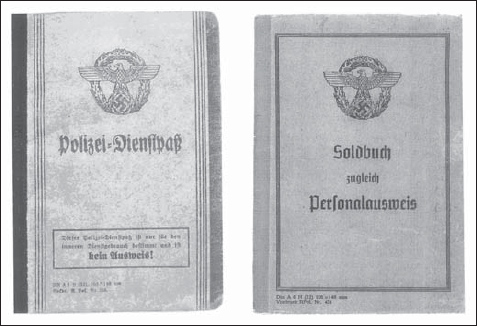
A series of long-service awards for the Police was introduced in January 1938. Awards were made on the completion of the requisite number of years of good conduct and loyal service, as follows:
8 Years A circular silvered medal 38mm (1.5in) in diameter, bearing the Police national emblem on the obverse, and the number ‘8’ within a wreath on the reverse. Worn on a plain cornflower-blue ribbon.
18 Years A silvered bronze cross c.43mm x 43mm (1.7in), with the Police emblem in an oval wreath overlaying the centre of the obverse. On the reverse centre an oval medallion bears the legend ‘Für Treue Dienst in der Polizei’ (For Faithful Service in the Police) in Gothic script. Worn on a cornflower-blue ribbon, with the Police emblem embroidered centrally in silver-grey thread.
25 Years A gilt bronze cross of the same dimensions and design as the above. Worn from a cornflower-blue ribbon, with the Police emblem embroidered centrally in golden-yellow thread.

The Bandenkampfabzeichen or Anti-Partisan War Badge, earned by many policemen serving in the occupied Eastern and Southern territories and awarded in three classes. A rare and desirable piece for collectors, this badge has been extensively counterfeited, sometimes with great skill.
Anti-Partisan War Badge
When serving in war zones, Police personnel were entitled to receive any military decorations for which their deeds qualified them. Thus the War Merit Cross, Iron Cross, Wound Badge, etc, were often awarded to members of the Schutzpolizei and Gendarmerie, especially those involved in anti-partisan operations in the occupied areas on the Eastern Front. One award specifically intended principally for SS and Police units – although also widely awarded to Wehrmacht personnel – was the Bandenkamp-fabzeichen (Anti-Partisan War Badge).

The Polizei Dienstpass, the Police equivalent of the military Wehrpass (left); and a pre-1943 example of the more detailed paybook or Soldbuch (right) – after that date the cover bore the SS runes in place of the Police national emblem. The cover of the Dienstpass clearly states that it is not intended as a formal ID document or Ausweiss; unlike the Soldbuch, it contained no photograph of the bearer.
Instituted by Himmler on 30 January 1944, the badge consisted of an oval wreath of oak leaves in the centre of which was an ancient sword, with a Germanic sunwheel swastika below the hilt, plunging down through a mythical hydra with five snakes’ heads – representing the partisans – into a death’s-head at the bottom of the wreath. The award was authorized in three grades: Bronze, for 20 days in action against partisans; Silver, for 50 days; and Gold, for 100 days.
The badge was in pin-back form, and worn on the left breast pocket. Initial production pieces were die-struck with a solid back, but the vast majority of examples encountered are die-cast in zink, with a semi-hollow back.
Police personnel were issued with a Dienstpass, which was roughly equivalent to the military Wehrpass, containing numerous personal details and records of training, postings, awards, etc. Unlike military Wehrpässe, however, these Dienstpasse rarely contain a photograph of the holder.
As a more formal identity document, the policeman received a Soldbuch, which was the direct equivalent of that issued to members of the armed forces. This paybook normally included a photograph of the bearer on the inside front cover, as well as personal details, a record of promotions, pay grades, kit issues, medical treatment, and many other minutiae of his service.
Both documents carried the Police national emblem on the cover until 1942; after that year the Soldbuch with the Police eagle was gradually replaced with a type bearing the SS runes.
A further form of ID carried by some Police officials was the warrant disc. This was an oval metal tag carried on a chain; the obverse showed the Police national emblem, and the reverse the Police organization to which the bearer belonged and his ID number. The best known of these tags were, of course, those issued to members of the Gestapo and the Kripo; these bore the legend ‘Geheime Staatspolizei’ or ‘Staatliche Kriminalpolizei’ as appropriate, above the serial number. Rarer than these in terms of numbers was the disc carried by members of the Gemeinde Polizei.